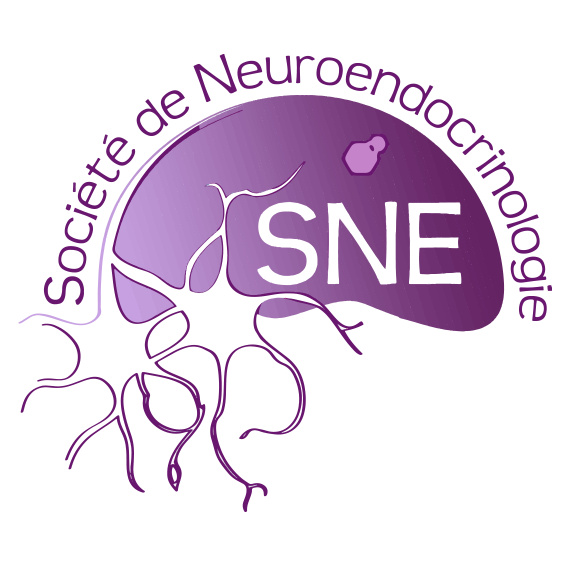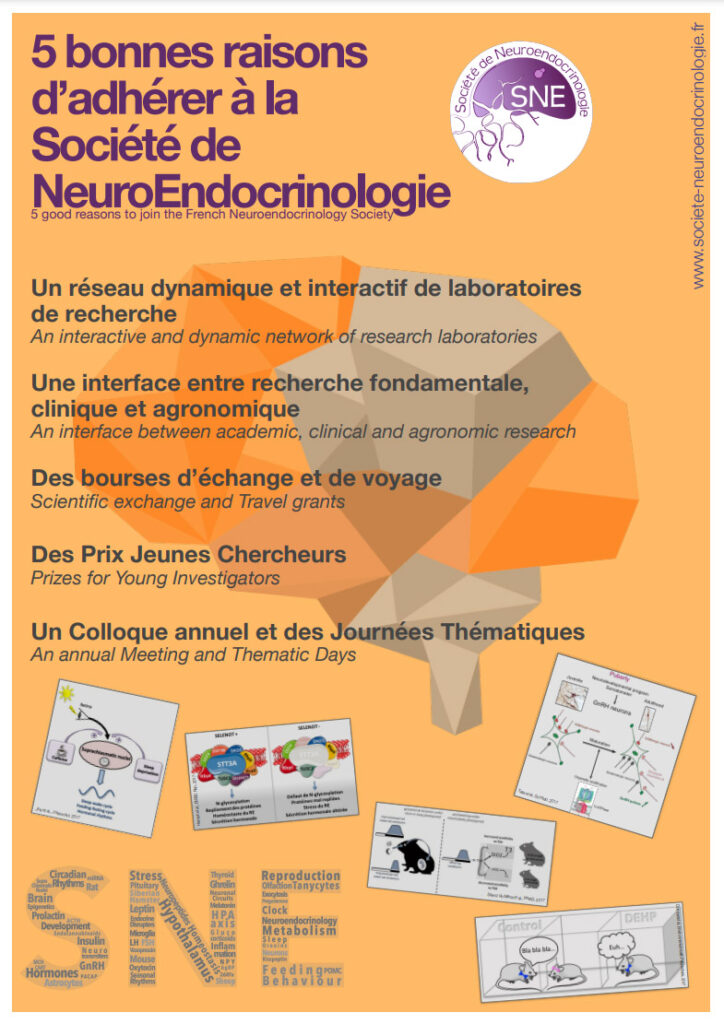Physiopathology of somatolactotroph cells : from transduction mechanismes to gene therapy
7ème Congrès International de Neuroendocrinologie-ICN2010 Rouen
Alain Enjalbert
Centre de Recherche en Neurobiologie-Neurophysiologie de Marseille
CRN2M-UMR6231-CNRS-Université de la Méditerranée-Université Paul Cézanne
Faculté de Médecine secteur nord
Marseille, France
In somatolactotroph cells, GPCRs and RTKs binding their specific ligands, trigger a cascade that converge to MAPKinase activation in subcellular compartement. Different signaling pathways, such as AC/ cAMP/PKA and Pi3K/AKT pathways interact with each other in order to regulate key physiological functions, as hormonal secretion and cell proliferation. To date, abnormalities affecting these signaling pathways have been identified as participating factors of pituitary tumorigenesis. Beside transsphenoidal surgery, the first-line treatment of GH secreting adenomas, somatostatin analogs are currently used to achieve control of hormonal hypersecretion. However, a subset of GH-secreting adenomas remains uncontrolled with these treatments, then requiring new therapeutic approaches. Improvement of our knowledge in pathophysiology of pituitary adenomas, specially in signaling pathways involved in tumoral cell proliferation, may contribute to identify new molecular targets in these canonical pathways. Co-targeting therapy would represent with gene therapy new promising tools in management of these problematic pituitary adenomas.
Alterations of the cAMP pathway appear as hallmarks of the large majority of GH secreting adenomas. In fact although cAMP negatively regulates cell proliferation in most of the cells it is strongly implicated in somatotroph cell proliferation depending on GHRH activation (1).

Figure 1
Gain of function mutations of the GNAS gene, causing constitutive activation of the cAMP pathway by inhibiting the intrinsic GTPase activity of Gs, have been identified in 30-40 % of GH-secreting adenomas (2).

Figure 2
Gs may thus be considered as the product of a proto-oncogene that is converted into an oncogene, designated gsp (3). Morever gsp negative GH secreting adenomas often exibit an over-expression of the wild type Gs protein, associated with alterations of the cAMP pathways (4, 5).

Figure 3
Cross talk of the cAMP pathway with the Erk 1/2 cascade as also been shown to play a major role in the regulation of hormonal secretion in somatolactotrop pituitary cell lines (6, 7, 8).
Using conditionnal Gs expressing cells we have shown that ERK is chronically activated following both gsp oncogene expression and Gs over expression. In addition activation of ERK 1/2 account for the observed hormonal hypersecretion induced by these two Gs alterations (9, 10). These alterations might both impact the tumoral phenotype through this sustained ERK 1/2 stimulation beside the compensatory mechanisms of cAMP pathway (11).
Indeed a marked increasse in phosphodiesterases activity (particularly variant PDE4D and PDE8) which contribute to cAMP hydrolysis, has been described in gsp tumors (12).
In somatotroph adenomas, quantification of the various somatostatin receptors and the use of new somatostatin analogs allowed to demonstrate the importance of sst2 and sst5 expression pattern in the control of GH secretion (13). Indeed activation of both sst2 and sst5 induced a functional association of the two receptor subtypes, resulting in synergistic GH suppression in primary human fetal pituitary cultures (14). Pasireotide (SOM230) a novel multireceptor ligand somatostatin analog with a unique receptor binding profile, with affinity for somatostatin receptor subtypes sst1-3 and sst5 was developed during last years, with efficacy and safety demonstrated in patients with acromegaly (15). Recently heterooligomerization of sst5 or sst2 and dopamine subtype 2 receptor (D2DR) have been also described, associated with enhanced efficacity in adenylate cyclase inhibition.
New somatostatin-dopamine chimeric molecules have thus been tested in GH secreting adenomas in vitro. In case of GH-resistant adenomas, we observed a better GH hormonal suppression with chimeric molecules than in presence of octreotide, suggesting a functional sst2-D2DR cooperation enhanced by chimeric dopamine-somatostatin agonist in this effect (16).
Previous studies showed that reintroducing sst2 by gene therapy into human pancreatic cancer cells leads to an inhibition of cell proliferation and tumorigenicity with local production of somatostatin, evoking an autocrine negative feed back loop (17, 18). As sst2 is down regulated in octreotide resistant GH secreting adenomas, we performed experiments in human somatotroph adenomas using adenoviral vector of sst2 gene transfer. sst2 transfer reversed octreotide resistance of GH secreting adenomas. Interestingly sst2 over expression without SRIF analogues, induced cell death of human somatotroph and lactotroph tumoral cells, through a caspase dependant mechanism (19).
These results suggested an intrinsec activity of the sst2 receptor, as recently described in AtT20 mouse pituitary corticotroph cells (20). This could in part explain that loss of sst2 expression itself may play a role in the deregulation of cell growth and hormonal secretion in tumorigenesis processes, suggesty sst2 as a tumor suppressor gene. In addition SST2 gene transfer may open new therapeutic strategies in treatment combined with somatostatin analogs.
In conclusion, signaling pathways involved in pituitary functions are multiple and complex. Among them, the MAPKinase cascade plays a fundamental role, and is able to interact with other signaling pathway to achieve a specific response. Improvement in the understanding of different pathways implication in a physiological and pathophysiological context would permit the emergence of novel therapies, besides usual somatostatin analogs.
Thus, pharmacological studies in targeting and co-targeting therapies such as mTOR and somatostatin analogs may represent, to date, a promising field of investigations, particularly in cases of invasive pituitary adenomas. A seductive approach may be the combined inhibition of distinct signaling pathway involved in pituitary tumorigenesis, using specific inhibitors or gene therapy, and then preventing the potential drug resistance secondary to feedback loops that could occur in a singular administration.
REFERENCES
1. Billestrup N, Swanson LW, Vale W. Growth hormone-releasing factor stimulates proliferation of somatotrophs in vitro. Proc. Natl. Acad. Sci. USA 1986; 83: 6854-6857.
2. Landis CA, Masters SB, Spada A, Pace AM, Bourne HR, Vallar L. GTPase inhibiting mutations activate the alpha chain of Gs and stimulate adenylyl cyclase in human pituitary tumors. Nature 1989; 340: 692-696.
3. Spada A, Vallar L, Faglia G. G protein oncogenes in pituitary tumors. Trends Endocrinol. Metab. 1992; 3: 355-360.
4. Picard C, Silvy M, Gerard C, Buffat C, Lavaque E, Figarella-Branger D, Dufour H, Gabert J, Beckers A, Brue T, Enjalbert A, Barlier A. Gsα overexpression and loss of Gsα imprinting in human somatotroph adenomas: association with tumor size and response to pharmacologic treatment. Int. J. Cancer 2007; 121: 1245-1252.
5. Pertuit M, Barlier A, Enjalbert A, Gerard C. Signalling pathway alterations in pituitary adenomas : involvement of Gsα, cAMP and Mitogen-Activated Protein Kinases. Journal of Neuroendocrinology 2009; 21: 869-877.
6. Le Pechon-Vallée C, Magalon K, Rasolonjanahary R, Enjalbert A, Gerard C. Vasoactive Intestinal Polypeptide and Pituitary Adenylate Cyclase-Activating Polypeptides stimulate Mitogen-Activated Protein Kinase in the pituitary cell line GH4C1 by a 3’, 5’- cyclic Adenosine Monophosphate Pathway. Neuroendocrinology 2000; 72: 46-56.
7. Coleman DT, Chen X, Sassaroli M, Bancroft C. Pituitary adenylate cyclase-activating polypeptide regulates prolactin promoter activity via a protein kinase A-mediated pathway that is independant of the transcriptional pathway employed by thyrotropin-releasing hormon.
8. Wang YH, Maurer RA. A role for the mitogen-activated protein kinase in mediating the ability of thyrotropin releasing hormone to stimulate the prolactin promoter. Mol.Endocrinol. 1999; 13: 1094-1104.
9. Romano D, Magalon K, Pertuit M, Rasolonjanahary R, Barlier A, Enjalbert A, Gerard C. Conditionnal overexpression of the wild type Gsα as the gsp oncogene initiates chronic extracellulary regulated kinase 1/2 activation and hormone hypersecretion in pituitary cell lines. Endocrinology 2007; 148(6): 2973-2983.
10. Romano D, Magalon K, Ciampini A, Talet C, Enjalbert A, Gerard C. Differential involvement of the Ras and Rap1 small GTPases in vasoactive intestinal and pituitary adenylyl cyclase activating polypeptides control of the prolactin gene. J. Biol. Chem. 2003; 278(51): 51386-94.
11. Barlier A, Pellegrini-Bouiller I, Gunz G, Zamora AJ, Jaquet P, Enjalbert A. Impact of gsp oncogene on the expression of genes coding for Gsalpha, Pit-1, Gi2alpha, and somatostatin receptor 2 in human somatotroph adenomas: involvement in octreotide sensitivity. J. Clin. Endoc. Metab. 1999; 84(8): 2759-2765.
12. Persani L, Borgato S, Lania A, Filopant M, Mantovani G, Conti M, Spada A. relevant cAMP-specific phosphodiesterase isoforms in human pituitary: effect of Gsα mutations. J. Clin. Endoc. Metab. 2001; 86: 3795-3800.
13. Jaquet P, Saveanu A, Gunz G, Fina F, Zamora AJ, Grino M, Culler MD, Moreau JP, Enjalbert A, Ouafik LH. Human somatostatin receptor subtypes in acromegaly : distinct patterns of messenger ribonucleic acid expression and hormone suppression identify different tumoral phenotypes. J. Clin. Endoc. Metab. 2000; 85: 781-792.
14. Ren SG, Taylor J, Dong J, Yu R, Culler MD, Melmed S. Functional association of somatostatin receptor subtypes 2 and 5 in inhibiting human growth hormone secretion. J. Clin. Endoc. Metab. 2003; 88(9): 4239-4245
15. Van der Hoek J, de Herder WW, Feelders RA, van der Lely AJ, Uitterlinden P, Boerlin V, Bruns C, Poon KW, Lewis I, Weckbecker G, Krahnke T, Hofland LJ, Lamberts SW. A single-dose comparison of the acute effects between the new somatostatin analog SOM230 and octreotide in acromegalic patients. J. Clin. Endoc. Metab. 2004; 89(2): 638-645.
16. Saveanu A, Lavaque E, Gunz G, Barlier A, Kim S, Taylor JE, Culler MD, Enjalbert A, Jaquet P. Demonstration of enhanced potency of a chimeric somatostatin-dopamine molecule, BIM-23A387, in suppressing growth-hormone and prolactin secretion from human pituitary somatatroph adenoma cells. J. Clin. Endoc. Metab. 2002; 87(12): 5545-5552.
17. Delesque N, Buscail L, Estève JP, Saint-Laurent N, Müller C, Weckbecker G, Bruns C, Vaysse N, Susini C. sst2 somatostatin receptor expression reverses tumorigenicity of human pancreatic cancer cells. Cancer Research 1997; 57(5): 956-962
18. Carrere N, Vernejoul F, Souque A, Asnacios A, Vaysse N, Pradayrol l, Susini C, Buscail L, Cordelier P. Characterization of the bystander effect of somatostatin receptor sst2 after in vivo gene transfer into human pancreatic cancer cells. Hum. Gen. Ther. 2005; 16(10): 1175-93.
19. Acunzo J, Thirion S, Roche C, Saveanu A, Gunz G, Germanetti AL, Couderc B, Cohen R, Figarella-Branger D, Dufour H, Brue T, Enjalbert A, Barlier A. Somatostatin receptor sst2 decreases cell viability and hormonal hypersecretion and reverses octreotide resistance of human pituitary adenomas. Cancer Research 2008; 68: 10163-10170.
20. Ben-Shlomo A, Zhou C, Pichurin O, Chesnokova V, Liu NA, Culler MD, Melmed S. Constitutive somatostatin receptor activity determines tonic pituitary cell response. Mol. Endocrinol. 2009; 23(3): 337-348.

